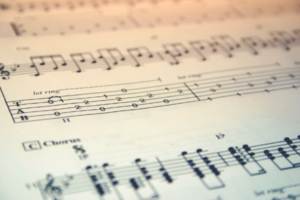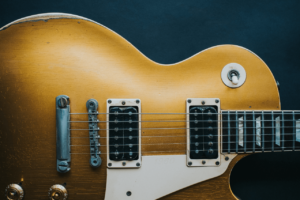If you’re a beginner, you may be thinking of taking acoustic guitar lessons.
And why not? It can help you learn the different finger names, string names, and parts of the guitar, among many others.
The great news is you can learn the same thing in this comprehensive guide.
So, without further ado, let’s get started!
Standard Guitar String Names and String Numbers
Every beginner lesson starts with these two crucial things. Without knowing these, you couldn’t play the chords and make beautiful music.
As such, you first need to know the names of the strings. Also known as note names, these strings are named from big to small (E – A – D – G – B – E).
As this sequence may be hard to remember, you may use these acronyms for guitar string names:
- Every American Dollar Goes Back East
- Elephants And Dogs/Donkeys Grow Big Ears
- Every Acid Dealer Gets Busted Eventually
- Eddie Ate Dynamite, Good Bye Eddie
On the other hand, the guitar strings are numbered from 1 to 6.
The number 1 starts from the thinnest string. It’s also known as the bottom string or the one closest to the floor.
The 6 represents the thickest string, the top string located farthest from the floor.
As you learn guitar string names, you’ll see that the name E corresponds to 6, A to 5, D to 4, and so on.
Guitar Finger Names
Apart from guitar string names, the fingers are named as well.
Your left-hand fingers—from the pointer to the little finger—are called 1, 2, 3, and 4. The thumb has no name, though some call it 0 or T.
The fingers on the right hand, which are often used to play the classical guitar, are labeled differently:
- Thumb – P or pulgar
- Index finger – I or indice
- Middle finger – M or medio
- Ring finger – A or anular
- Little finger – C or chiquito (some use d, ñ, and ch as well)

Guitar Parts
Acoustic guitars and electric guitars have instrument parts named after the body.
The headstock includes the tuners and tuning pegs, which are involved in tuning, as the name suggests.
On the other hand, the neck contains the nut, the white strip near the headstock. It also includes the fret and fretwire, discussed in detail below.
The lower third—or the body—is the biggest part of the guitar. It has a large hole, aptly called the soundhole. It also includes the table, strings, and saddle/bridge.
The body also contains bridge pins that keep the wires in place.
While it’s good to memorize these parts whenever you play guitar notes, knowing only the strings, frets, and tuning keys is just as good.
Guitar Fretboard Numbers
Frets are illustrated as horizontal lines on your guitar. You’ll see them as cross pieces on the guitar neck.
Like guitar strings, they are numbered. Zero pertains to the open string because no finger is pressed on it.
From zero, the number moves from 1 and onwards.
When it comes to a classical guitar, you’ll find the 12th fret on the crossroads of the neck and the body.
Press the string behind the fret whenever you’re playing. Not only is this the correct way, but it can also make your guitar sound better.
Tips on Standard Guitar Tuning

Now that you know the string names, finger names, and guitar parts, it’s time for you to tune your guitar.
The easiest way is to purchase a basic guitar tuner. Another option is to make an open string sound like another string. This essentially helps your guitar tune itself.
Here’s how to do so:
- Place your finger on the fifth fret of the low E string (also known as the bottom string).
- Play the open 5th string until both notes sound the same.
- If you fail to get the same tune, tune the key of the 5th string until it matches that of the 6th string.
- Repeat the same process with the other strings.
When you tune the 2nd string, remember to press the 4th fret of the 3rd string instead of the 5th. In other words, when you tune strings 6 to 1, the order should be 55545.
Remember: doing this procedure doesn’t always mean your guitar is automatically ‘in tune.’
Standard tuning forks are set to 440 hertz, where A vibrates 440 times per second. In other words, it will tell you it’s tuned if they detect this sound.
Another thing: new students like you will need a lot of practice to perfect tuning. That said, you can train your ear by using an tuner first.
Once you get familiar with the right sound, you can tune your guitar manually and with relevant ease.
As you see, learning acoustic or electric guitar names and numbers is relatively easy. As long as you know these things by heart, you’ll be playing great guitar music in no time.
Thanks to Bryan and our friends down at Classical Guitar Shed for the very helpful Guest Post.








